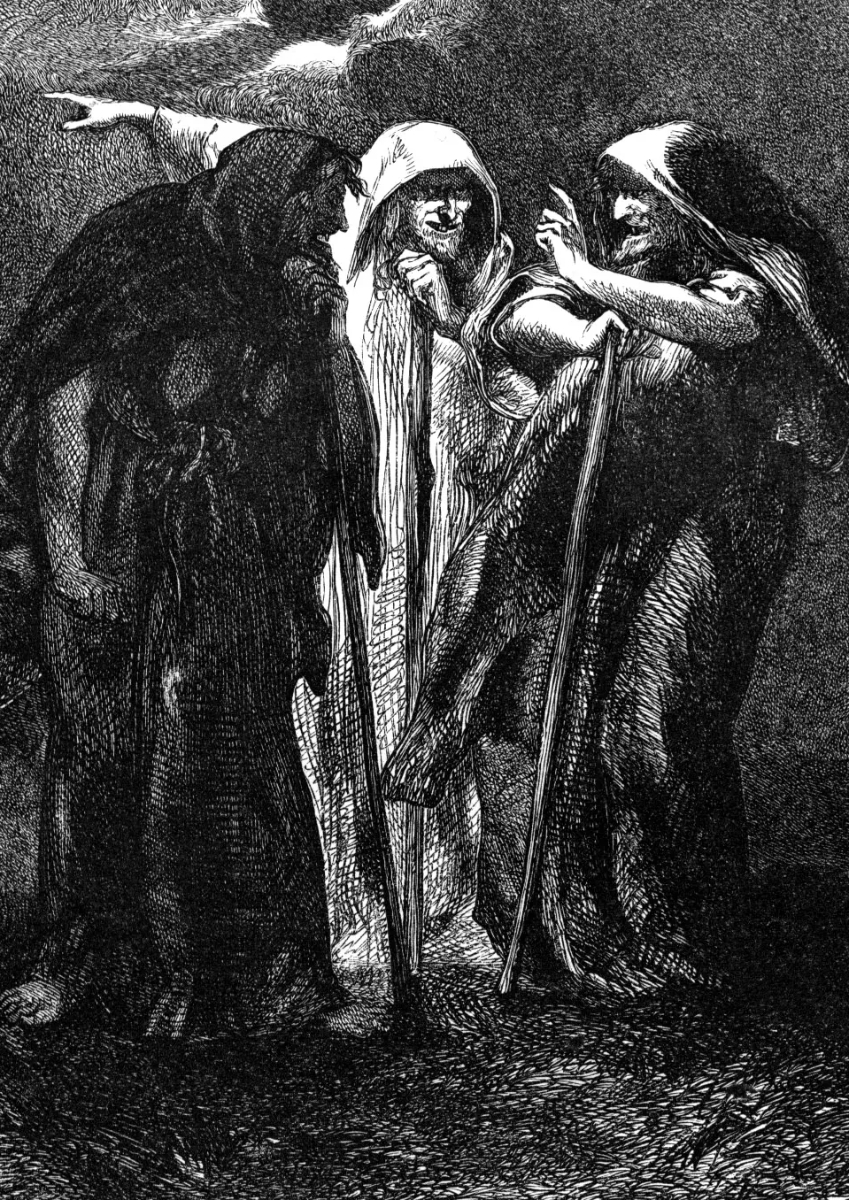The Three Witches, also known as the Weird Sisters, Weyward Sisters or Wayward Sisters, are characters in William Shakespeare’s play Macbeth (c. 1603–1607). The witches eventually lead Macbeth to his demise, and they hold a striking resemblance to the three Fates of classical mythology. Their origin lies in Holinshed’s Chronicles (1587), a history of England, Scotland and Ireland. Other possible sources, apart from Shakespeare, include British folklore, contemporary treatises on witchcraft as King James VI of Scotland’s Daemonologie, the Witch of Endor from the Bible, the Norns of Norse mythology, and ancient classical myths of the Fates: the Greek Moirai and the Roman Parcae. Shakespeare’s witches are prophets who hail Macbeth early in the play, and predict his ascent to kingship. Upon killing the king and gaining the throne of Scotland, Macbeth hears them ambiguously predict his eventual downfall. The witches, and their “filthy” trappings and supernatural activities, set an ominous tone for the play. Artists in the 18th century, including Henry Fuseli and William Rimmer, depicted them variously, as have many directors since. Some have exaggerated or sensationalized the hags, or have adapted them to different cultures, as in Orson Welles’s rendition of the weird sisters as voodoo priestesses.
| Alias The Three Witches |
| Real Names/Alt Names Unknown |
| Characteristics Trickster, Literary Characters, Witch, Seer, Medieval Age, Scottish |
| Creators/Key Contributors William Shakespeare |
| First Appearance Shakespeare’s Macbeth first performed 1606 (probably before King James I) |
| First Publisher Edward Blount and William and Isaac Jaggard |
| Appearance List Mr. William Shakespeares Comedies, Histories, & Tragedies – Published according to the True Originall Copies, i.e. First Folio (1623) |
| Sample Read Mr. William Shakespeare’s Comedies, Histories, & Tragedies [Internet Archive] |
| Description The Three Witches, also known as the Weird Sisters, Weyward Sisters or Wayward Sisters, are characters in William Shakespeare’s play Macbeth (c. 1603–1607). The witches eventually lead Macbeth to his demise, and they hold a striking resemblance to the three Fates of classical mythology. Their origin lies in Holinshed’s Chronicles (1587), a history of England, Scotland and Ireland. Other possible sources, apart from Shakespeare, include British folklore, contemporary treatises on witchcraft as King James VI of Scotland’s Daemonologie, the Witch of Endor from the Bible, the Norns of Norse mythology, and ancient classical myths of the Fates: the Greek Moirai and the Roman Parcae. Shakespeare’s witches are prophets who hail Macbeth early in the play, and predict his ascent to kingship. Upon killing the king and gaining the throne of Scotland, Macbeth hears them ambiguously predict his eventual downfall. The witches, and their “filthy” trappings and supernatural activities, set an ominous tone for the play. Artists in the 18th century, including Henry Fuseli and William Rimmer, depicted them variously, as have many directors since. Some have exaggerated or sensationalized the hags, or have adapted them to different cultures, as in Orson Welles’s rendition of the weird sisters as voodoo priestesses. |
| Source Three Witches – Wikipedia |



